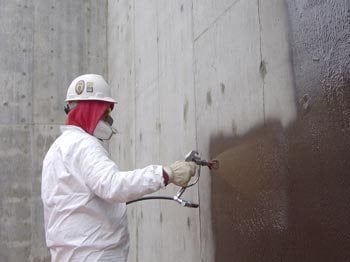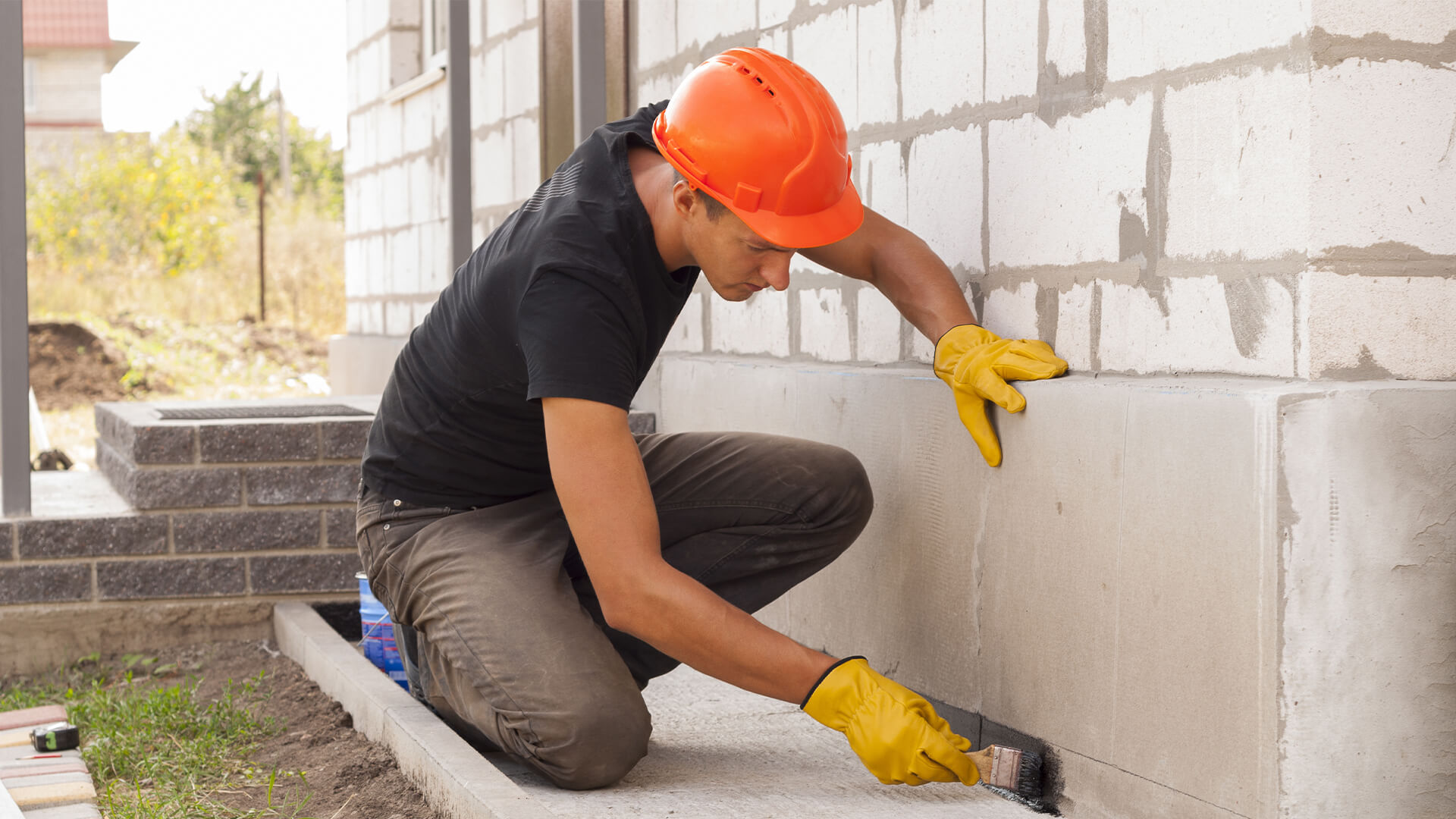Why Waterproofing Is Crucial for Long-Lasting Frameworks: a Thorough Analysis
Waterproofing plays an important function in the durability of structures. It acts as a barrier against dampness, which can cause considerable issues like mold and wear and tear. Recognizing the numerous waterproofing approaches and their effects is critical for building owners. The effects of overlooking this facet can be extreme. Checking out these components reveals not just the need of waterproofing, but likewise its wider effect on residential or commercial property value and security.
Understanding Waterproofing: Definition and Value
Waterproofing acts as an essential obstacle against wetness breach, protecting frameworks from potential damage. It includes different techniques and products developed to protect against water penetration right into structures, guaranteeing long life and functionality. The importance of waterproofing can not be overstated, as it secures versus a variety of problems, consisting of mold and mildew growth, damage of products, and architectural weakening.Effective waterproofing solutions can include membranes, coverings, and sealants, each customized to particular settings and architectural layouts. By producing a safety layer, these services assist maintain a dry interior, which is crucial for the wellness of occupants and the preservation of residential or commercial property value.Moreover, buying waterproofing at the building stage is considerably extra cost-efficient than dealing with water-related concerns after they occur. Comprehending the principles of waterproofing is crucial for architects, builders, and residential or commercial property owners intending for long lasting, durable structures that endure the examination of time and ecological difficulties.

The Effect of Water Damages on Architectural Honesty
Water damages positions considerable risks to structural integrity, mostly through the growth of mold and mildew and mildew. These microorganisms not only jeopardize indoor air quality however additionally result in product deterioration with time. Furthermore, extended direct exposure to dampness can compromise architectural components, enhancing the probability of collapse or failing.
Mold and Mildew Development
Dampness breach postures a substantial danger to the architectural honesty of structures, bring about the expansion of mold and mildew and mold. These fungis thrive in wet atmospheres, commonly settling in covert locations such as wall surface cavities, under floor covering, and in ceilings. Their development not just develops unattractive stains and unpleasant odors but also adds to a decrease in indoor air high quality, presenting health and wellness dangers to passengers. Mold and mildew can endanger products like wood and drywall, resulting in further dampness retention and producing a cycle of damage. Early discovery and removal are important to stop substantial growth, underscoring the need of efficient waterproofing measures. Resolving dampness problems promptly can shield both the wellness of occupants and the long life of the structure.
Architectural Weakening Dangers
Uncontrolled wetness intrusion can bring about serious architectural weakening, endangering the honesty of structures. Water damage usually impacts fundamental elements, such as beams, columns, and wall surfaces, resulting in jeopardized load-bearing capacity. Prolonged exposure to dampness can cause products like timber to rot and steel to corrode, damaging their structural residential or commercial properties. This deterioration may cause cracks, bowing, or even tragic failures if left unaddressed. Water Solutions Omaha. Furthermore, water seepage can undermine the soil below structures, creating settling or changing that further intensifies structural threats. As an outcome, executing efficient waterproofing options is critical in preserving a building's architectural honesty, protecting against expensive fixings, and making sure safety for residents. Appropriate maintenance and positive actions are necessary in mitigating these substantial threats connected with water damages
Types of Waterproofing Approaches and Materials
Waterproofing techniques and products play a crucial role in safeguarding frameworks from water damage. Trick methods include membrane waterproofing, which gives a physical barrier; fluid waterproofing options that develop a smooth coat; and cementitious waterproofing options known for their durability and ease of application. Comprehending these numerous approaches is important for picking one of the most ideal approach for details construction requirements.
Membrane Layer Waterproofing Methods
Membrane waterproofing strategies are essential for securing structures from the damaging results of water infiltration. These methods entail the application of water-proof membrane layers that develop a barrier against dampness. The two primary sorts of membrane systems are sheet membrane layers and liquid-applied membranes. Sheet membrane layers, normally made from materials such as rubberized asphalt or polycarbonate, are upraised and can be turned out and stuck to surfaces. On the other hand, liquid-applied membranes are applied as a liquid and treatment to form a seamless layer. Both types offer adaptability and sturdiness, satisfying different applications, including roof coverings, basements, and structures. Proper setup and maintenance of these membrane layers guarantee long-lasting protection, improving the life-span and stability of the frameworks they protect.
Fluid Waterproofing Solutions
Liquid waterproofing options stand for a functional choice to typical membrane layer systems. These remedies typically entail the application of liquid finishings that treat to develop a seamless, resilient barrier versus water seepage. Different sorts of liquid waterproofing products are offered, including polyurethane, bitumen, and acrylic-based formulations. Each kind supplies one-of-a-kind residential or commercial properties, such as flexibility, attachment, and UV resistance, making them appropriate for varied applications. The application procedure commonly includes spraying or rolling the fluid onto surface areas, permitting coverage of intricate forms and details, which decreases prospective weak factors. Liquid waterproofing options are particularly advantageous for areas with motion, such as joints and splits, as they can fit architectural changes without compromising integrity, guaranteeing durable defense for frameworks.
Cementitious Waterproofing Options
Various cementitious waterproofing options are readily available, using efficient solutions for different building requirements. These systems commonly consist of a mix of cement, sand, and ingredients, making them ideal for both exterior and interior applications. Among the prominent choices are crystalline waterproofing items, which react with moisture to form a water resistant barrier within the concrete matrix. Furthermore, adaptable cementitious layers provide enhanced elasticity, accommodating minor structural movements without compromising try here the waterproofing honesty. It is also usual to use cementitious sealers for joints and cracks, making certain detailed protection versus water seepage. Generally, cementitious waterproofing choices are valued for their toughness, convenience of application, and compatibility with different substratums, making them a preferred option in modern-day construction methods.
Long-Term Cost Cost Savings With Reliable Waterproofing
Purchasing efficient waterproofing options can greatly reduce long-term expenses for building owners and designers. By protecting against water intrusion, these options mitigate damage to architectural components, minimizing the demand for expensive repair work and maintenance gradually. Waterproofing additionally shields indoor coatings and home furnishings, minimizing replacement costs and enhancing the total life expectancy of the property.Moreover, efficient waterproofing can cause energy cost savings by enhancing insulation and decreasing humidity-related problems. This results in lower cooling and heating costs, adding to a much more sustainable economic design for residential or commercial property management.Additionally, the implementation of waterproofing measures can boost building worth by making certain a completely dry, safe, and sturdy atmosphere. While the first investment in waterproofing might seem significant, the lasting economic advantages much surpass the in advance prices, making it a sensible choice for any individual included in construction or property management.

The Function of Waterproofing in Structure Codes and Rules
Waterproofing plays a substantial role in structure codes and laws, mirroring its value in contemporary building methods. These codes are designed to guarantee safety and security, durability, and sustainability in structures, stressing the demand for efficient waterproofing steps. Various nationwide and neighborhood structure codes detail certain needs for waterproofing products and methods, especially in locations susceptible to water intrusion, such as cellars and foundations.Compliance with these regulations not only secures frameworks from moisture-related damage but also safeguards public wellness by protecting against mold and mildew growth and architectural instability. Assessors typically examine waterproofing aspects throughout the building and construction process to guarantee adherence to developed requirements. As climate adjustment enhances the regularity of extreme weather condition events, the duty of waterproofing in building ordinance is anticipated to develop, possibly resulting in more stringent guidelines. On the whole, the combination of waterproofing in governing frameworks emphasizes its important function in achieving resilient, resilient frameworks.
Instance Studies: Effective Waterproofing Solutions
Successful waterproofing solutions have actually been executed throughout various tasks, showcasing ingenious strategies that enhance structural honesty and longevity. One significant instance is the remodelling of the historic Smith Tower in Seattle, where innovative membrane layer systems were employed to safeguard the framework from water breach. This approach not only preserved the structure's visual but likewise prolonged its lifespan.In one more instance, a huge commercial building in Miami utilized crystalline waterproofing technology, which reacts with wetness to develop an obstacle versus water. This option confirmed reliable versus the city's high moisture and hefty rainfall.Additionally, a bridge in San Francisco undertook a considerable waterproofing treatment utilizing epoxy coatings, which substantially reduced upkeep prices and boosted sturdiness. These study illustrate the effectiveness of tailored waterproofing approaches in diverse settings, highlighting the importance of choosing ideal methods to address certain obstacles and ensure the durability of structures.
Ideal Practices for Implementing Waterproofing Techniques
Implementing reliable waterproofing strategies calls for cautious planning and adherence to finest methods - Water Solutions Omaha. It is essential to carry out a detailed website evaluation to recognize potential locations of water access. This evaluation informs the selection of suitable materials and strategies tailored to details ecological problems. Using premium, resilient waterproofing membrane layers can substantially boost security against moisture.Additionally, correct setup methods are vital; guaranteeing that surface areas are clean and cost-free from pollutants advertises perfect bond. Normal maintenance checks ought to be set up to identify any kind of indicators of wear or damage, enabling prompt repairs.Moreover, integrating drain systems can efficiently manage water runoff, avoiding build-up around frameworks. Educating all personnel associated with building and construction about waterproofing demands further assurances uniformity and adherence to finest practices. Ultimately, a positive technique to waterproofing can substantially extend the lifespan of frameworks and reduce long-lasting upkeep expenses
Regularly Asked Inquiries
Just How Does Waterproofing Affect Energy Effectiveness in Structures?
Waterproofing significantly improves energy effectiveness in buildings by avoiding dampness intrusion. This decreases the need for home heating and air conditioning, maintains constant interior temperature levels, and inevitably lowers power consumption, contributing to long-lasting sustainability and price financial savings.
Can Waterproofing Be Applied to Existing Structures?
Waterproofing find this can certainly be related to existing frameworks. Numerous approaches, such as membranes, finishings, and sealants, enable property owners to boost security against moisture, therefore lengthening the structure's integrity and lowering possible damage over time.
What Are the Indicators of Inadequate Waterproofing?
Indicators of poor waterproofing include water stains on wall surfaces, mold development, peeling paint, musty smells, and moisture in basements - Water Solutions. These signs suggest possible structural damage and the demand for instant focus to avoid further damage
Just How Frequently Should Waterproofing Be Evaluated or Preserved?
Waterproofing ought to be checked at the very least every year, specifically in areas with hefty rainfall or ever-changing temperatures. Normal maintenance assurances very early detection of problems, advertising structural stability and lengthening the life expectancy of the building.
Exist Eco-Friendly Waterproofing Options Available?
Green waterproofing site here alternatives are progressively available, making use of sustainable products such as bio-based polymers and natural sealers. These options not just secure frameworks yet also lessen ecological impact, attracting ecologically aware builders and homeowner.